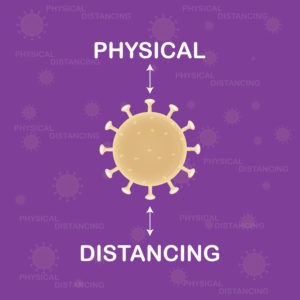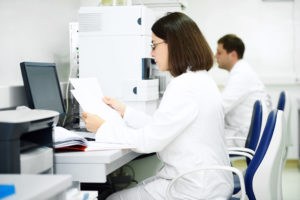Laboratories can be crowded places. We are used to working around other people, tossing ideas back and forth. Dark rooms, cold rooms and large equipment spaces are often shared by several labs. Some labs have shut down completely in response to the COVID-19 pandemic; others, especially those labs doing research around coronavirus biology, testing and detection and drug development are running continually. For those labs, maintaining the recommended 6-foot (2m) distance to help stem the coronavirus pandemic isn’t easy.

At Promega our operations, quality assurance, applications and research and development labs are up and running—focused on providing as much support as possible to our partners who are studying, diagnosing and developing treatments for COVID-19. At the same time, we are maximizing the safety of our employees. Here are a few ways we have found to maintain critical distances in our laboratory that might help your lab group stay productive and safe too.
- Work in shifts. Have half of your staff working at any one time. Myra Schink, Manager of Bulk Production (Protein Purification) at Promega says that partners in a purification process for her group work every other day. Myra’s team also adds some fun to the shift work by giving the teams creative names like “Team TAQuito” (Taq Polymerase production) or “R2T2” (MMLV-RT production). Our chemists at Promega Biosciences are also dividing into two shifts, blue team and gold team. When the blue team is on site, no person from the gold team can come to the building and vice versa. This dramatically reduces the number of people on site, and facilitates physical distancing.
- Designate entrance and exit doors and break areas for each shift. Eliminating or minimizing the common space that different groups use can help prevent spread of virus from one group of workers to another. Have separate entrances and exits designated for teams, if possible. Assign parts of common areas like break rooms to different teams to minimize crossover.
- If you can work remotely, do so. Lab members can stay connected for group meetings and journal clubs using remote meeting software like Zoom or Skype. Our office personnel are working from home, but lab members can do that too. At Promega Biosciences, chemists are asked to do analysis and writing work from home.
- If you must be in confined spaces, stagger the work. Ensure that dark rooms, negative-pressure labs and hot lab areas are used by one person at a time. This requires communication among all lab members, and may even require communication between labs in a department that share equipment like autoclaves, dishwashers and centrifuges.
- When two people must work in proximity, set up barriers. Barriers include things like lab coats, gloves, masks and safety glasses. They can also be closed doors and portable space dividers or even a bench-top incubator placed strategically between two individual work areas.
- Create a “mud room” for the lab. Find a place where you can remove your outside shoes and coats and change them for a lab coat, a different set of shoes or maybe put on lab booties.
- Make a place for that PPE to be discarded or hung up before you leave the lab. Lab coats, gloves, masks and other PPE should never leave a laboratory, in any circumstance, but in a pandemic this guideline takes on extra importance.
- Follow the CDC guidelines for disinfecting laboratory surfaces. Remember that surfaces are not just the lab bench but include things like doorknobs, light switches, common equipment, computer keyboards, shared pipettes, and microscope oculars. Have a routine set up and train your lab members to disinfect areas after finishing their work. Have a sign out procedure so that the next person in the lab space knows that it has been cleaned.
- Ask your Health and Safety experts at your institution to assess your laboratory and make recommendations.
- Our Chief Medical Officer at Promega reminds us that the number one method of infection is far and away “self-inoculation”…or touching your face…which means our number 1 method of prevention rests in our own CLEAN hands.”

These are a few suggestions for maintaining physical distancing and laboratory productivity during the current epidemic. How are your laboratories tackling this problem? Leave a comment to share your creative solutions.
Related Posts
Michele Arduengo
Latest posts by Michele Arduengo (see all)
- An Unexpected Role for RNA Methylation in Mitosis Leads to New Understanding of Neurodevelopmental Disorders - March 27, 2025
- Unlocking the Secrets of ADP-Ribosylation with Arg-C Ultra Protease, a Key Enzyme for Studying Ester-Linked Protein Modifications - November 13, 2024
- Exploring the Respiratory Virus Landscape: Pre-Pandemic Data and Pandemic Preparedness - October 29, 2024

We cant wear masks or there is no distancing in our lab
I’m glad you talked about having separate entrances and exits for team members. My brother is going back to the college’s lab this week and they are worried about maintaining social distance when working. I’ll send him this so he can set more regulations and keep their lab clean and safe.
I love that you explained how confined spaces in lab that are dark and pressured negatively are used by only a single person at a time to ensure safety. My friend who wants to manufacture her own makeup lab is looking into laboratory design consultation services to make sure everything’s in order. As a person who doesn’t know the facets of a lab’s structure, she’s smart for asking professional help!